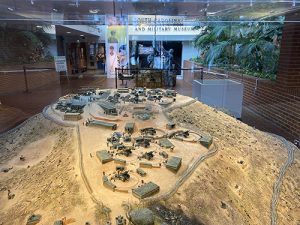At the Relic Room, hear about what the battle of Firebase Ripcord was like
February 10, 2023As visitors approach the entrance of the South Carolina Confederate Relic Room and Military Museum, the first thing they see is a huge diorama of Fire Support Base Ripcord, depicting in meticulous detail the site of the very last major battle the U.S. Army experienced during the Vietnam War.
Craig Van Hout likes to visit the diorama. But when he sees other museum visitors “basically do a 60-second walk-by, I want to say get back here!” He wants them to take it in completely, and understand what happened at Ripcord.
He knows, because he was there, with his comrades of the 506th Regiment, 101st Airborne Division – too many of whom never made it home. He will talk about the experience in a free lecture at noon on Friday, Feb. 24, at the Relic Room. Those who attend can broaden their knowledge of the war further after the program by visiting the major new exhibit that fills the museum’s Cistern Gallery – “A War With No Front Lines: South Carolina and the Vietnam War, 1965-1973.”
The battle Craig Van Hout and the other American soldiers fought at Ripcord is remembered as one of the bloodiest of the war. They lost 139 killed. Four hundred were wounded in the month of July alone. Three Medals of Honor and six Distinguished Service Crosses were awarded to men who were there that month.
The last night, just before Craig’s unit had to abandon the base, was the worst. Alpha company fought a running battle against North Vietnamese regulars – NVA – on another hill nearby. Fourteen of them were killed, and 56 were wounded. When it was over, “only 10 men walked back into the company area at Camp Evans.”
The next day, Craig and his team were ordered to lay down a field of fire as the helicopters came in to evacuate them from Ripcord. That’s when he was hit by an enemy mortar round. He was seriously wounded, and not for the first time. He had multiple piece of shrapnel in his skull. He went around looking for help, but all the medics had already been flown out. It took him three days to get treated in an actual hospital because “the hospitals were full.”
After he went home, Craig never went back to Vietnam. But he’s thought a lot about it, and not just about the guys who fought on his own side. He wonders what it was like for “some poor North Vietnamese guy who walked all the way down the Ho Chi Minh Trail” carrying five heavy artillery rounds on his back – either on bicycle or walking. He hand-carried those shells into the mountains, to the NVA artillery position. Craig contemplates the contrast to what he experienced at Ripcord, an artillery base where all the ammunition was flown in by helicopter.
Then, Craig imagines how before the North Vietnamese guy even turned around to leave, “Those five rounds had been fired at Ripcord.” At him and his buddies, killing so many of them.
Craig survived, and lives in Columbia today. He’s glad to be able to tell the story to fellow Americans who weren’t there – especially since when it happened, nobody back home heard about it.
A year earlier, at another hill there in the A Shau valley, soldiers of the 101st had also sustained heavy losses. It became the subject of a Hollywood movie you may have seen, or at least heard of – “Hamburger Hill.”
Ripcord fell at a time when the Nixon administration wasn’t talking much about battles and losses. Consequently, “Nobody ever heard of Ripcord” back in the States, says Craig.
But they can come hear him tell the story now.
About the South Carolina Confederate Relic Room and Military Museum
Founded in 1896, the South Carolina Confederate Relic Room and Military Museum is an accredited museum focusing on South Carolina’s distinguished martial tradition through the Revolutionary War, Mexican War, Civil War, Spanish-American War, World Wars I and II, Vietnam, the War on Terror, and other American conflicts. It serves as the state’s military history museum by collecting, preserving, and exhibiting South Carolina’s military heritage from the colonial era to the present, and by providing superior educational experiences and programming. It recently opened a major new exhibit, “A War With No Front Lines: South Carolina and the Vietnam War, 1965-1973.” The museum is located at 301 Gervais St. in Columbia, sharing the Columbia Mills building with the State Museum. For more information, go to https://crr.sc.gov/.


















